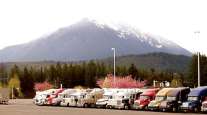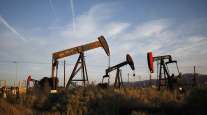DOT Study Offers Road Map for Obama Fuel Economy Plan
This story appears in the May 31 print edition of Transport Topics.
A new U.S. Department of Transportation study hints that the Obama administration’s recently announced plans to increase heavy truck fuel efficiency and to reduce greenhouse gas emissions likely will rely on a combination of existing aerodynamic design technologies and future diesel engine and drivetrain modifications that barely have left the laboratory or still are in development.
The 600-page study, presented to Congress last month, offers a road map of DOT’s latest thinking on transportation’s role in reducing greenhouse gas emissions and improving heavy truck fuel economy and efficiency.
“Reducing the greenhouse gas emissions that contribute to global climate change is one of the great challenges of our time,” Transportation Secretary Ray LaHood said in a recent statement. “This report provides valuable information that will help us in our effort to protect the environment.”
The study, a requirement contained in the Energy Independence and Security Act of 2007, was a joint effort by DOT’s Center for Climate Change and Environmental Forecasting and transportation consultant Cambridge Systematics Inc., Cambridge, Mass.
It was completed just weeks before President Obama signed a proclamation instructing DOT and the U.S. Environmental Protection Agency to work together toward the adoption of a greenhouse gas reduction rulemaking for medium- and heavy-duty trucks.
The study is likely to guide the federal government’s efforts to set a fuel economy standard for large trucks. On May 21, Obama announced that DOT and EPA would collaborate to issue a proposal later this year to regulate medium- and heavy-duty truck fuel economy for the first time starting in the 2014 model year (see story, p. 3).
The study said that greenhouse gas emissions from the U.S. transportation sector have grown by 27% from 1990 to 2006. However, over that same period, medium and heavy-duty truck emissions increased 77%.
The study said that the increases were driven by factors ranging from the expansion of freight trucking after the industry was deregulated in the 1980s, to just-in-time manufacturing and retailing and more time-sensitive shipments.
However, truck fleets that have adopted SmartWay-certified vehicles and trailers are estimated to use 10% to 20% less fuel per truck when compared with conventional vehicles.
SmartWay applications, including devices such as low-rolling resistance tires, planar boattail plates, front fairings, fuel tank skirts and aluminum wheels, have the potential to increase fuel economy in Class 8 vehicles by as much as 7.45 miles per gallon, according to the study.
Aerodynamic drag-reduction options — for example, closing or covering the gap between the tractor or trailer, a lower front bumper air dam, underside air baffles and wheel-well covers — already are available for retrofitting to trucks and would improve fuel efficiency, although they “have not yet achieved significant market penetration,” the study said.
Electronic vision systems that could replace large, protruding side mirrors with small cameras are not yet commercially available. However, the study said their use could become more widespread if safety regulations were modified to allow downsizing or replacing mirrors.
Heavy-truck greenhouse gas reduction strategies being explored in engine power systems and transmissions are showing promise, but many are still in development stages.
The study said several different primary ways in which heavy-duty powertrains can be modified to reduce greenhouse gas emissions include: in-cylinder/combustion improvements that modify the way air and fuel flow into the engines, and accessory load-reduction that decreases the power needs for pumps, air compressors, electrical power generation, cooling fans and air conditioning.
Other powertrain modifications include frictional loss reductions that generate waste heat in the engine and transmission — decreasing the power that otherwise could be used to drive the wheels — and hybridization approaches that use two power-delivery sources and recover braking energy to improve overall efficiency.
The study also highlighted the promise of engine modifications that recently have entered the market, such as variable geometry turbo, which involves movable surfaces in the exhaust turbine that allow control over the speed of the compressor.
Two-stage turbocharging, improved engine materials, designs and fuel injectors also were mentioned in the study as ways to reduce greenhouse gas emissions and improve fuel efficiency.
However, the study noted that motor carriers might not quickly deploy even aerodynamic, engine and powertrain technologies that are currently or soon to be available. Not only can they be costly, but some of them also need to be designed into a new vehicle and therefore are not feasible as retrofits.
“Profit margins in the trucking industry tend to be small, and operators typically only make improvements to vehicles and systems when the costs and benefits are clear and previously demonstrated in real-world operations,” the study stated.
Engine technologies such as heavy-duty hybridization face technical hurdles, as well.
“Heavy-duty hybrid market penetration is several years below the current level in the light-duty marketplace,” the study said. “Many issues exist that present challenges before heavy-duty hybrids can gain a foothold in the market.”
The study also said that allowing longer and heavier vehicles on U.S. highways would use less fuel per ton-mile of goods carried and translate to fewer trucks on the road.
Although heavier trucks would cause more damage to the nation’s infrastructure, the study said, vehicle owners and shippers would benefit significantly from reduced carrier operating costs.
Heavier vehicles would be likely to cause the trucking industry to capitalize on its shorter, more direct, more reliable and faster routes between origins and destinations to capture 10% to 15% of the current rail market, the study said.
“Rail is a more efficient mode, so any diversion from freight rail to truck would represent a negative greenhouse gas reduction benefit,” the study said.




